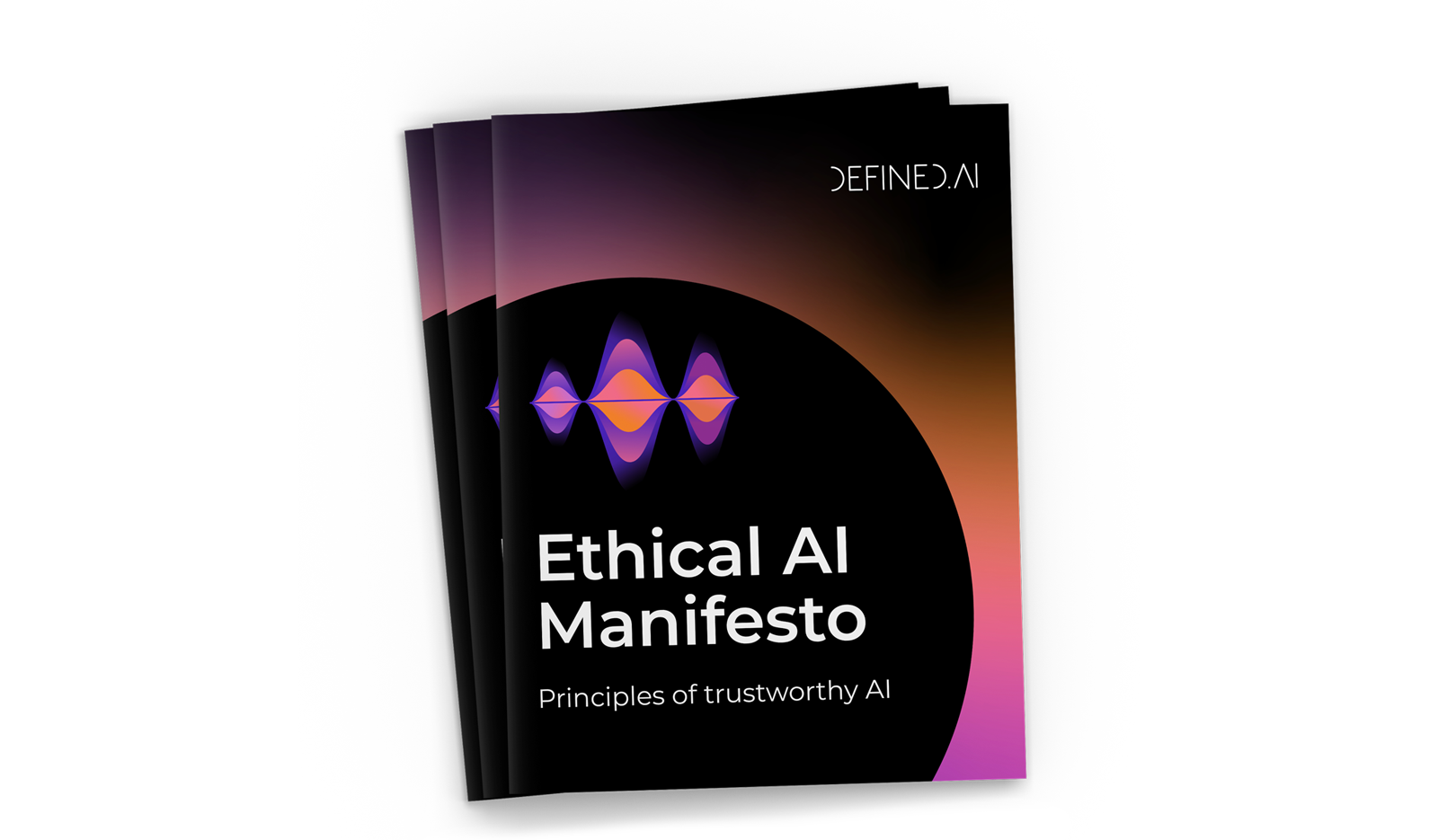What is Generative AI? Explanation, Use Cases & Trends (2025 Guide)
1 Oct 2025
What is generative AI? Even though it’s quickly moved from an emerging concept to a core business technology, many people are still wondering how to use it to grow their businesses.
In this comprehensive guide, we will demystify what generative AI is— its capabilities and applications—and explore its potential impact on your company through real-world use cases. We’ll share tips on how to stay ahead in a fast-moving regulatory landscape, and how to choose training data that improves model performance while protecting your reputation.
By the end of this article, you’ll have a solid understanding of what generative AI is and how it can be a game-changer for your business when used responsibly. So, let’s get generating!
Generative AI vs. Predictive AI
“Traditional” AI is typically predictive: it classifies data, makes forecasts or identifies patterns (e.g. spam detection, fraud detection, recommendation engines).
Generative AI, by contrast, is creative: it doesn’t just analyze, it produces. Instead of telling you whether an email is spam, it can write the email; instead of just recognizing an image, it can create one.
This shift expands AI’s role from support tool to co-creator.
At its core, generative AI is a subset of artificial intelligence that leverages machine learning models to create new data from existing ones. As if you were giving your computer the ability to dream, imagine and create.
Understanding the capabilities of generative AI is the first step in channeling its power for your business. Now that you know what generative AI is, let’s learn more about the science behind the technology.
The Science: Generative Modeling
Generative AI operates based on a type of machine learning called generative modeling. This involves training an AI on a dataset until it can make educated “guesses” about how to create new data.
To better understand what generative AI is, imagine a young child learning to draw. At first, their work is simple and lacks detail. But as they practice, their drawings become more detailed and accurate, eventually resembling the objects they’re trying to depict.
This is similar to how generative AI learns. It starts by analyzing a large amount of data. Over time, it identifies patterns and structures, allowing it to create new data using its training.
Earlier Generative AI Approaches
For much of the 2010s, Generative Adversarial Networks (GANs) and Variational Autoencoders (VAEs) were the engines of generative AI. GANs worked by pitting two neural networks against each other: one generating data, the other judging it, leading to highly realistic outputs. VAEs compressed input data into a lower-dimensional representation and sampled it to produce new outputs.
These methods were especially successful in generating images and laid the groundwork for the AI creativity boom.
Transformer Models: GenAI Goes Mainstream
Since 2020, transformer architectures have become the dominant force. Transformers underpin large language models (LLMs) like GPT-4.5, Claude 3, Gemini, and open-source systems like LLaMA 3. Unlike GANs and VAEs, transformers excel at handling sequential data—such as language—enabling them to generate coherent text, write code and even power chatbots and copilots embedded in productivity tools.
Transformers have since expanded into multimodal AI, capable of working across text, images, audio, and video. This makes them the backbone of today’s generative AI systems.
Diffusion Models
Another major breakthrough has been diffusion models, the technology behind tools like Stable Diffusion, MidJourney and Runway Gen-3. Instead of adversarial training, diffusion models generate images and videos by gradually transforming random noise into structured content. This approach is now state of the art for high-quality image and video synthesis.
By understanding these underlying technologies, businesses can better exploit the power of generative AI and apply it in ways that benefit their operations.
Want to see generative AI in action? Check out our case studies to see how we’ve helped customers realize their AI solutions with ethically sourced data.
Real-world Applications of Generative AI
To better understand what Generative AI is, let’s explore some of its many applications. Here’s an overview of the most prominent ones:

Video Generation
Diffusion models can now create highly realistic video clips from text prompts, storyboards, or still images. These tools are transforming industries such as advertising, film, education and training, where custom video content can be produced quickly and cheaply.
For example, an e-learning company could create explainer videos in multiple languages, reducing the need for expensive reshoots or dubbing.
Speech Recognition, NLP & Voice Synthesis
Generative AI is transforming the way machines process and produce human language by combining speech recognition, natural language processing (NLP) and voice synthesis. These systems go beyond simple transcription: they can interpret intent, respond contextually, and generate speech that feels natural and adaptive.
Modern speech-to-text models can transcribe conversations in real time with high accuracy, even in noisy environments or across multiple speakers. Paired with NLP, these transcripts can be instantly analyzed for meaning, sentiment, or intent—allowing AI to not just capture words but also understand context. On the output side, voice synthesis technologies enable virtual agents to reply in lifelike, customizable voices that can shift tone, style or language depending on the user.
These capabilities are increasingly deployed in customer support, accessibility tools and global communications. Imagine a global telecom provider with a large, multilingual customer base. They could deploy AI-powered virtual agents to handle customer inquiries in dozens of languages, cutting wait times and improving customer satisfaction.
Text Generation
Generative AI models trained on large amounts of text data—LLMs—can generate coherent and contextually relevant sentences, paragraphs, or even entire articles. This can be used for tasks such as drafting emails, writing reports or creating content.
For instance, a business could use a generative AI model to automate the creation of product descriptions for their online store. This not only saves time but also ensures consistency across all product descriptions.
Image Generation
AI models are designed to generate new images, from creating realistic human-like faces to designing product images. This technology can be used in various sectors, including entertainment, fashion, and design.
For example, a fashion company could use generative AI to create images of new clothing designs, allowing them to visualize different styles before physically producing the clothes.
Music and Sound Generation
Generative AI can produce new pieces of music or sound effects based on learned patterns. It can even mimic the style of specific genres or instruments, which can be used in the entertainment industry.
For instance, a video game company could use generative AI to create unique soundtracks for their games, providing a more immersive experience for players.
Data Augmentation
Generative AI can produce synthetic data to enhance datasets. This is useful when handling datasets lacking balance or when additional data is required to train machine learning models.
For example, a healthcare company could generate synthetic patient data to build more robust AI models without compromising patient privacy. This approach could support the use of high-quality, real-world medical datasets, which are valuable for diverse healthcare AI applications.
Personalized Experiences
Generative AI can create personalized customer experiences, from customized product recommendations to personalized music playlists.
For example, an e-commerce platform could use generative AI to provide personalized product recommendations based on a customer's browsing history and preferences.
This can enhance customer satisfaction and loyalty, leading to increased sales and customer retention.
These real-world use cases demonstrate the transformative potential of generative AI in the business world.
Browse the world’s largest data marketplace! Each of Defined.ai’s datasets are curated for real-world GenAI business applications.
Generative AI Risks and Compliance (GDPR & Beyond)
Alongside generative AI’s extraordinary opportunities lay a range of ethical, legal and regulatory challenges that you cannot afford to overlook. These risks extend across data protection, misinformation, intellectual property and compliance with emerging laws.
One major concern is data privacy. Regulations such as the GDPR place strict limits on how personal data can be collected, stored, and used. While many companies turn to synthetic data as a safer alternative for training AI models, the risk remains that outputs could inadvertently reveal sensitive or identifiable information. Organizations must put safeguards in place to ensure AI-generated results are anonymized and compliant.
Another pressing issue is the rise of deepfakes and misinformation. Generative AI can create hyper-realistic content, from fabricated videos of public figures to false documents, which has profound implications for elections, brand trust, and public safety. Businesses must consider both defensive strategies—such as watermarking AI outputs—and proactive monitoring to mitigate reputational damage.
Copyright and intellectual property also remain in the spotlight. Training AI on creative works—whether music, art, or written text—without consent raises questions of ownership and fair use. This has led to a growing wave of lawsuits and regulatory discussions around compensating creators and enforcing usage rights in training datasets.
Finally, governments are responding with new regulatory frameworks. The EU AI Act sets the most comprehensive rules to date, requiring transparency, watermarking of AI-generated content, and risk management systems. In the U.S., recent executive orders have mandated audits for bias, monitoring of high-risk AI applications and reporting obligations for large model developers. Together, these laws signal a new era of accountability.
Generative AI Trends
The future of generative AI for businesses looks promising. As the technology matures, it's expected to drive significant transformations across various industries. Here are a few predictions:
Increased Adoption
As more businesses understand generative AI's benefits, its adoption will likely increase across different sectors. This could lead to a surge in innovative applications, from automating content creation to enhancing data analysis.
Improved Quality
As the technology evolves, the quality of output generated by AI models is expected to improve, reducing the need for human intervention. This could lead to more efficient processes and higher-quality results in areas like content creation, design and data augmentation.
New Applications
As researchers push the boundaries of what's possible with generative AI, we can expect new and innovative applications to emerge. These could range from new approaches to personalization to breakthroughs in fields like healthcare, where generative AI could be used to simulate patient outcomes or design personalized treatment plans. Video generation, synthetic speech and multimodal copilots are expected to become mainstream. In finance, generative AI could generate fraud scenarios for safer systems.
Ethical and Regulatory Frameworks
In Defined.ai's Ethical AI Manifesto, we emphasize the need for robust ethical guidelines and regulatory frameworks. Given the potential misuse of generative AI, advocating for these frameworks is crucial in ensuring the responsible use of technology and maintaining public trust. In 2025, ethical AI debates increasingly focus on watermarking AI outputs, managing bias audits and addressing the risks of generative AI in elections and misinformation campaigns.
How Generative AI Will Redefine Business Operations and Growth
Generative AI is a powerful technology that uses machine learning to generate new, original data. With applications ranging from content creation to data enhancement, it's already driving innovation in various industries. Despite some challenges, the future of generative AI for businesses looks promising, with increased adoption, improved quality, and new applications on the horizon.
The journey of generative AI is in full swing, and it's set to redefine the way businesses operate in the future. By staying informed and prepared, businesses like yours can benefit from generative AI to drive innovation, efficiency and growth.

